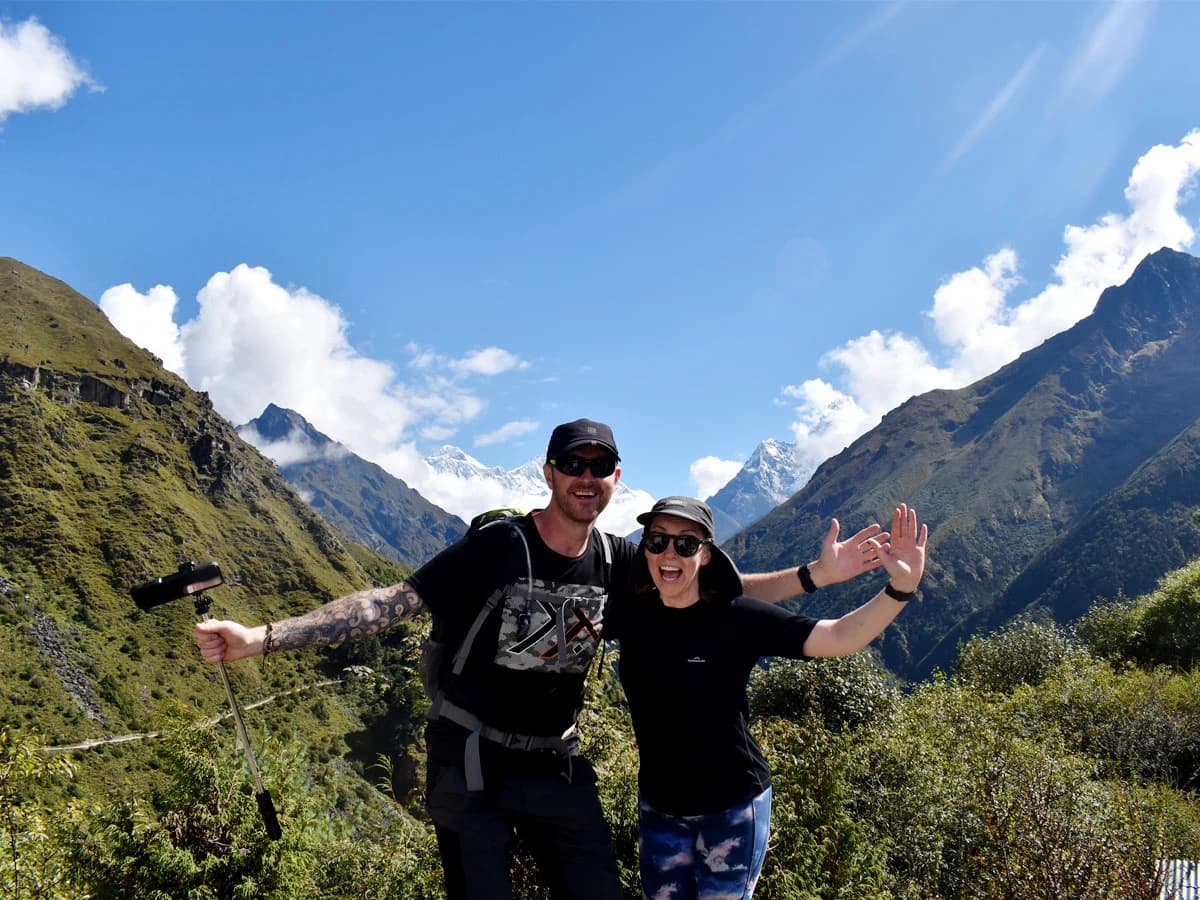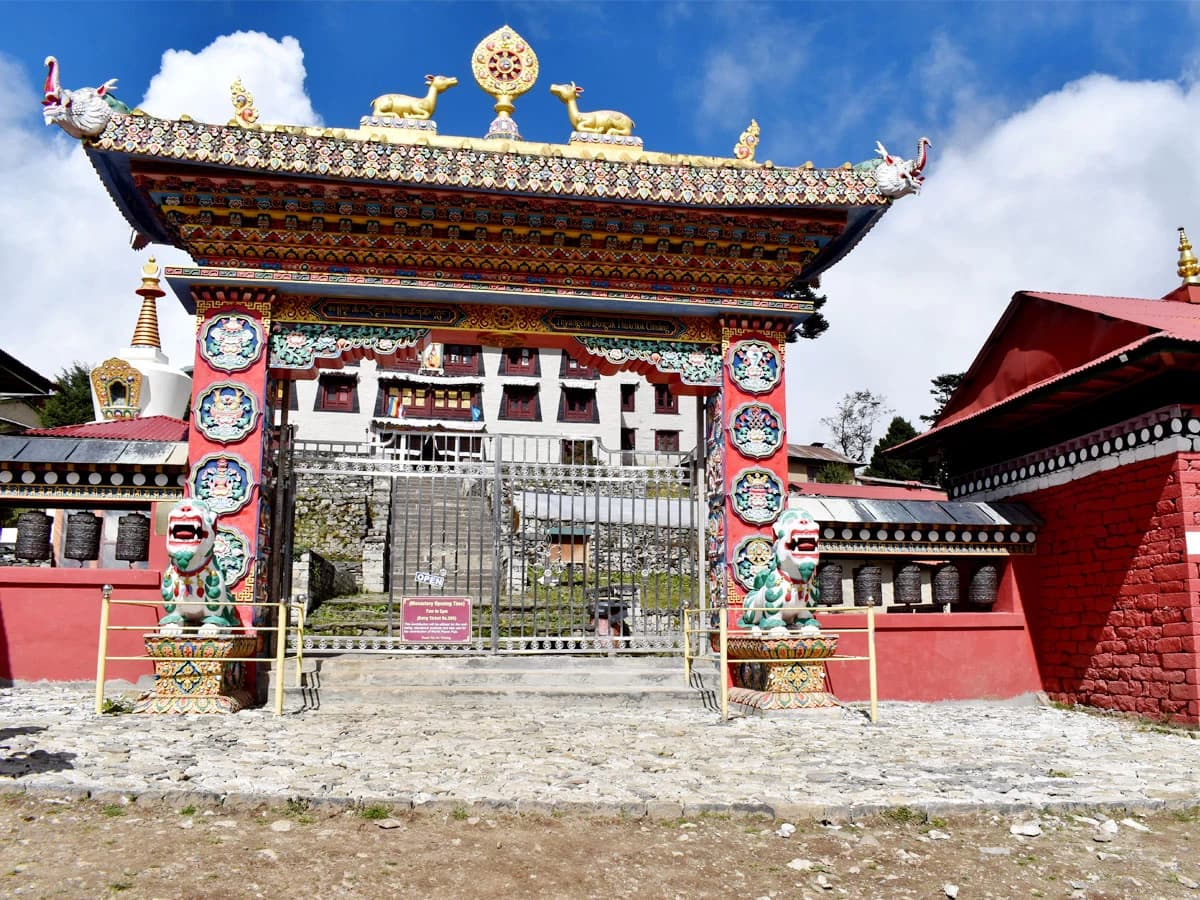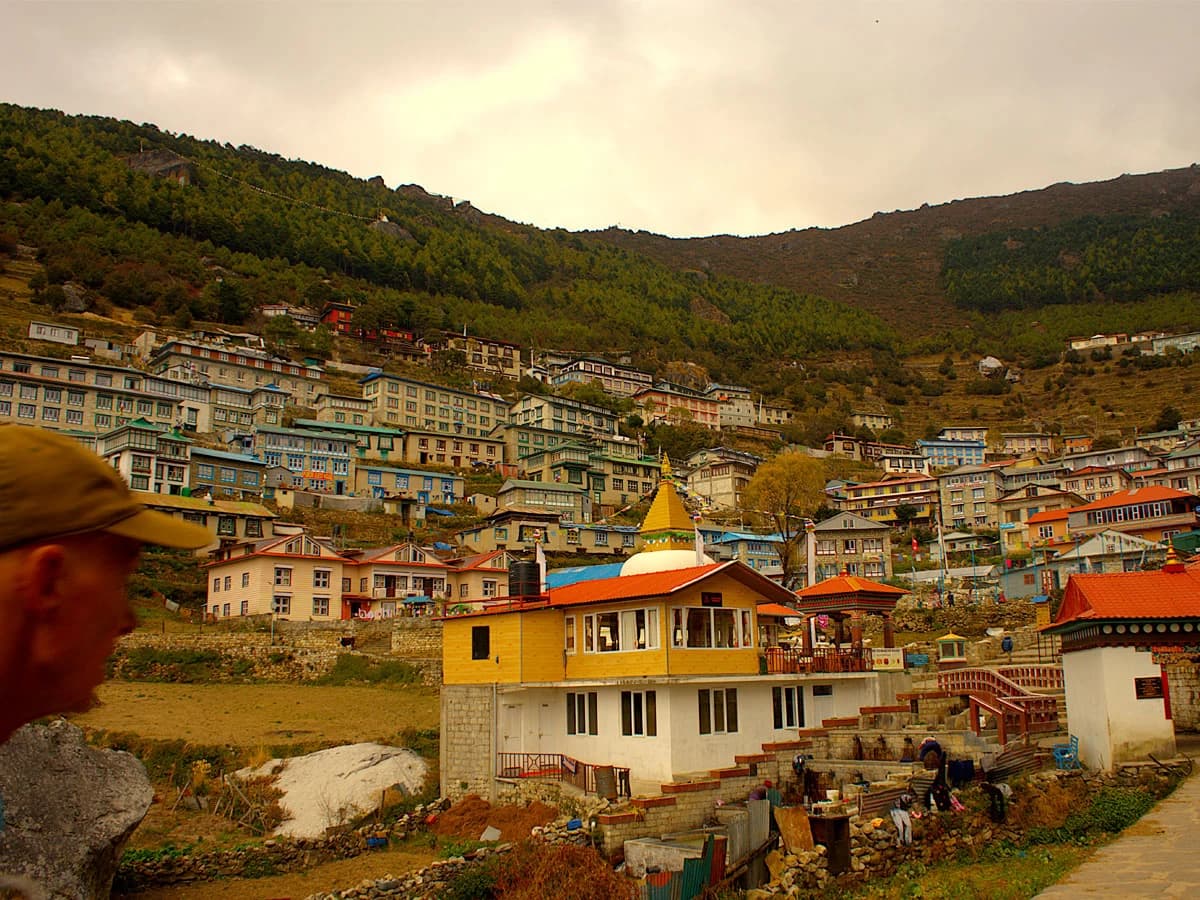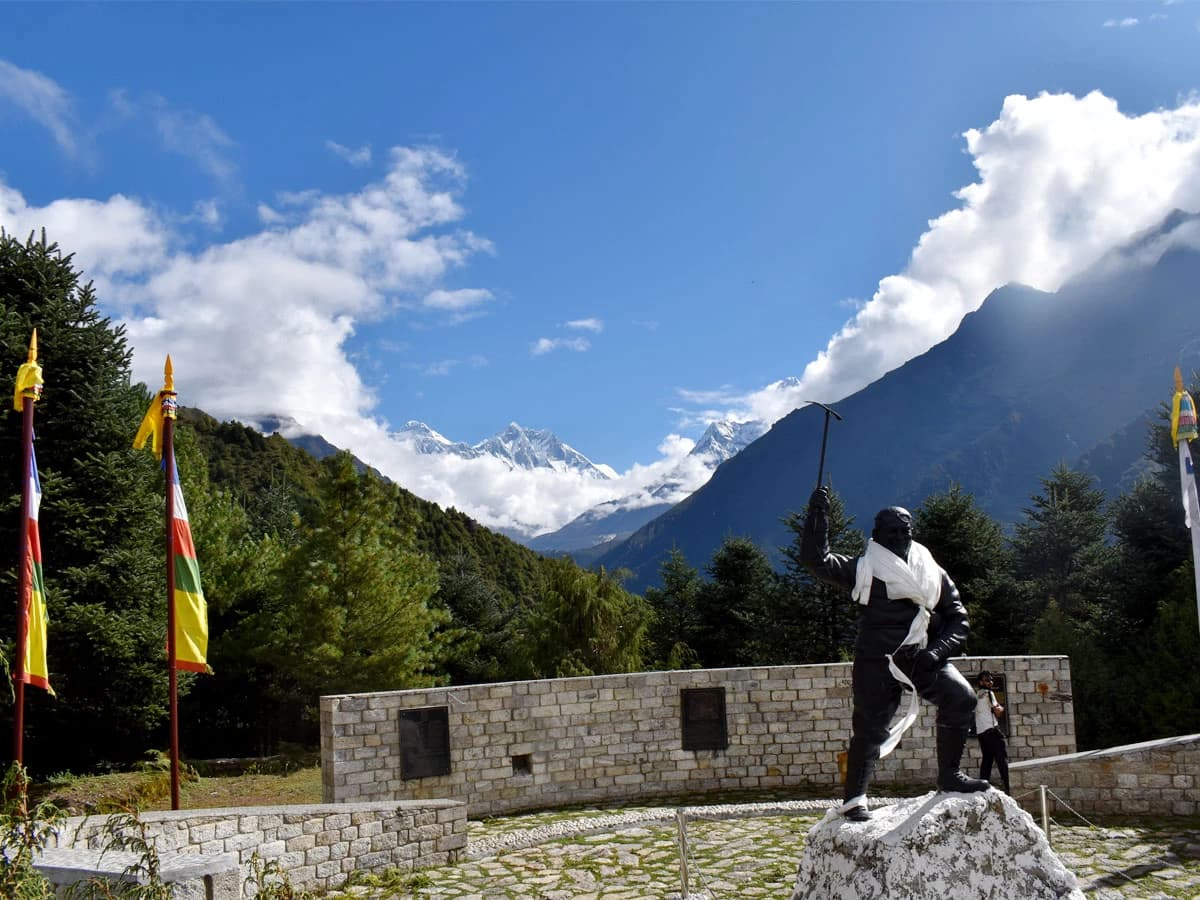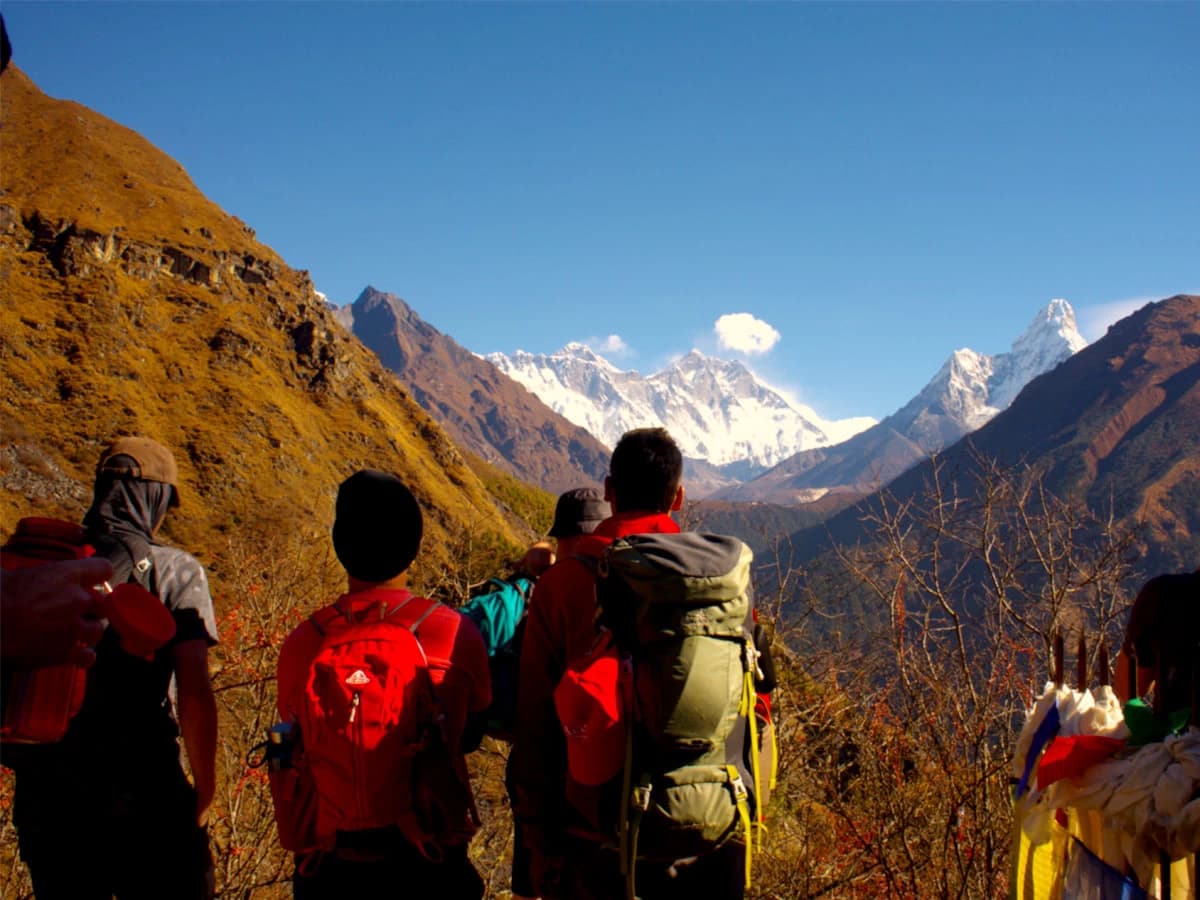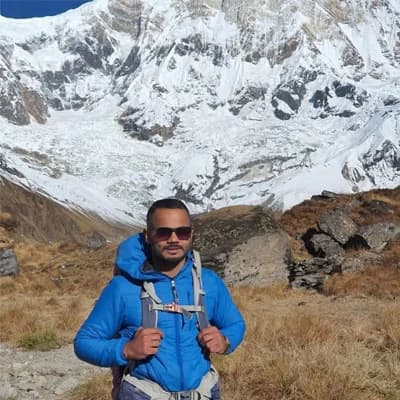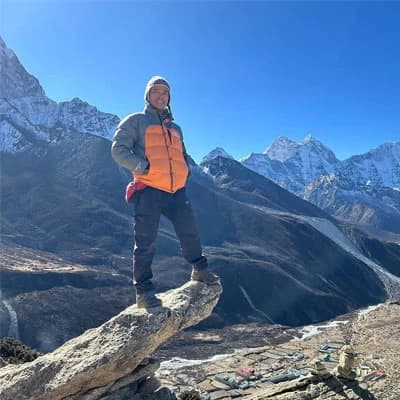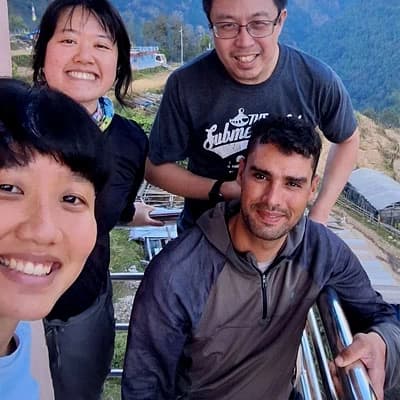The Everest View Trek is an ideal choice for those seeking a short Everest trek that offers a thrilling adventure with panoramic views of Mount Everest, Ama Dablam, Lhotse, Kongde Ri, Kusum Kanguru, Nuptse, and Thamserku. The easy trek with Everest View takes you through charming Sherpa villages like Namche Bazaar, Tengboche, and Monjo. With a visit to the iconic Tengboche Monastery, acclimatization days, and an optional hike to the Everest View Hotel, the trek offers breathtaking Himalayan landscapes, iconic suspension bridges, and the unique biodiversity of Sagarmatha National Park.
Everest View Trek
Highlights
- Thrilling flight to Lukla, offering one of the world’s most exciting and scenic flights
- Panoramic views of the snow-capped Himalayas, including Mount Everest, Ama Dablam, Lhotse, Kongde Ri, and Kusum Kanguru
- Visit to the serene Tengboche Monastery, an important cultural and spiritual site
- Acclimatization day in Namche Bazaar with optional hikes to Syangboche Viewpoint and the Everest View Hotel for stunning mountain vistas
- Explore Sherpa villages like Namche, Tengboche, and Monjo, offering cultural immersion and local hospitality
- Visit the World’s Highest Pub in Namche Bazaar, a unique experience for trekkers
- Cross iconic suspension bridges over the Dudh Koshi River, adding adventure to the journey
- Encounter Himalayan wildlife and stunning flora as you trek through Sagarmatha National Park
- Experience beautiful sunrise and sunset views over the Everest massif
- Explore the vibrant markets of Namche Bazaar, shop for souvenirs, and interact with friendly locals
- The Everest View Trek is for trekkers seeking to experience the grandeur of the Everest region within a limited timeframe. This short yet rewarding journey provides panoramic views of the world’s tallest peaks, including Mount Everest, Ama Dablam, Lhotse, Thamserku, Kongde Ri, and more.
The adventure begins with a thrilling flight to Lukla, one of the world’s most exciting airports, followed by a trek through picturesque Sherpa villages, suspension bridges, and dense rhododendron forests.
Trekkers pass through Sagarmatha National Park, a UNESCO World Heritage site known for its diverse flora, fauna, and captivating landscapes that offer unforgettable experiences.
A highlight of the journey is Namche Bazaar, a lively Sherpa trading hub filled with bustling markets, cozy teahouses, and rich cultural experiences. On Day 3, trekkers spend an acclimatization day exploring this iconic village, with opportunities to visit the world’s highest Irish pub for a unique high-altitude experience.
Optional hikes to the Everest View Hotel and Syangboche Viewpoint reward adventurers with stunning, unobstructed views of Everest, Ama Dablam, and other majestic peaks, making this day both memorable and essential for a successful trek.
Another experience is a short hike to Khumjung village, home to the famous Khumjung Monastery, which houses a relic believed to be the scalp of a Yeti. This mysterious artifact has drawn intrigue and curiosity from adventurers and researchers alike, adding an element of folklore and legend to the trek. The path winds through rhododendron forests and past chortens (Buddhist shrines), with panoramic mountain views accompanying the journey.
The trek reaches its pinnacle at Tengboche Monastery (3,867m) on day 4, a spiritual landmark set against Everest and Ama Dablam. Known for its peaceful ambiance and rich history, the monastery draws visitors to witness Buddhist rituals and explore unique cultures and traditions.
With comfortable tea house accommodations and minimal altitude risk, the Everest View Trek is a perfect choice for travelers short on time who want a fulfilling taste of the Everest region’s natural beauty and Sherpa culture without the challenges of more demanding routes.
Everest View Trek Itinerary
Early in the morning, after breakfast, Himalayan Massif Trek will pick you up from your hotel and shuttle you to either Kathmandu’s Tribhuvan International Airport or the Ramechhap Airport in Ramechap.
From there, you will board a flight to Lukla. The 35-40-minute flight is both adventurous and scenic, offering spectacular views of the snow-covered peaks of the Himalayas, including Mount Everest.
Upon landing in Lukla, you will be greeted by your porters. After a brief rest and safety briefing, you will start your trek towards Phakding. The trail begins with a gentle descent, following the Dudh Koshi River, as you pass through charming Sherpa villages and lush forests. Along the way, you will cross suspension bridges that offer stunning views of the valley below.
After a steady 3-4 hour trek, you will arrive in Phakding, a quaint Sherpa village, where you will settle into a cozy tea house for your first night in the mountains.
After breakfast in Phakding, we begin our trek with a steady climb alongside the Dudh Koshi River, crossing several suspension bridges, including the famous Hillary Bridge.
The trail takes us through the small villages of Benkar and Monjo, where we stop to show our Sagarmatha National Park Permit and TIMS (Trekkers' Information Management System) card at the park entrance. (Himalayan Massif Trek will provide the necessary permits for your journey.)
After the permit check, we continue towards Jorsalle, the last village before Namche. Here, we take a break before tackling the final stretch of steep switchbacks up to Namche Bazaar. Along the way, we get our first views of Mount Everest.
Namche Bazaar, a vibrant Sherpa town, offers stunning views of Everest, Lhotse, and Ama Dablam. It’s a cultural hub, known for its markets, cafes, and monastery. This day combines a physical challenge with cultural immersion, marking an important step in your Everest journey.
Today is an essential acclimatization day, allowing your body time to adjust to the higher altitude. You will have the day to explore the town and its surroundings. With its lively atmosphere, Namche is a great place to relax and experience the local culture.
In the morning, you can visit the Namche Bazaar Monastery or hike up to the Syangboche Viewpoint for spectacular views of Mount Everest, Lhotse, and Ama Dablam. This hike takes about 1 to 2 hours, offering great photo opportunities and close-up views of the majestic mountains.
You can also go to the Everest View Hotel, the highest hotel in the world, for panoramic views of the Everest massif. Another must-see is the famous Irish Pub in Namche Bazar (the world’s highest-located pub), a unique spot to unwind and meet fellow trekkers while enjoying a drink and the stunning surroundings.
The afternoon is free for more exploration or relaxation. You can visit the local markets in Namche Bazaar, which offer a variety of goods, from trekking supplies to local handicrafts. Take the opportunity to rest, as proper acclimatization is key to ensuring a safe and successful trek.
If necessary, trekkers are welcome to stay longer in Namche Bazaar to further acclimatize before continuing the journey.
Day 4 begins with a trek to Tengboche. The trail takes you through beautiful pine forests, with occasional views of Mount Everest and other peaks as you descend into the Dudh Koshi Valley.
The path gradually ascends, offering fantastic views of Ama Dablam, Lhotse, and the towering Everest as you approach the village of Tengboche. Tengboche is renowned for its iconic Tengboche Monastery, one of the Khumbu region's largest and most significant spiritual centers.
As part of the Tengboche Trekking Package, this serene destination offers travelers a perfect opportunity to pause, immerse themselves in the tranquil ambiance, and, if the timing allows, witness a captivating prayer session that enriches the cultural experience.
On day 5 the path descends steeply at first before gradually leveling out as you make your way towards the village of Phunki Tenga, where you can take a break.
From Phunki Tenga, the trail continues along the river, passing through several small villages and offering more stunning views of the mountains.
As you approach Monjo, you will cross suspension bridges over the Dudh Koshi River, which adds to the adventure and beauty of the day.
Monjo, a peaceful Sherpa village, serves as a great spot to rest for the night. It’s a quieter stop compared to Namche Bazaar, providing a perfect opportunity to reflect on the journey so far. Settle into your tea house, enjoy the local cuisine, and rest after a rewarding day of trekking.
The trail follows the same route as your earlier journey, but this time you are descending back toward the starting point of your adventure. The trail takes you through picturesque villages and along the Dudh Koshi River, crossing suspension bridges and enjoying views of the surrounding peaks.
As you trek, you will pass through the villages of Phunki Tenga and Benkar, each offering peaceful surroundings and opportunities to take in the landscape.
The final section of the trek gradually climbs toward Lukla, where you will arrive after about 5 to 6 hours of walking.
After breakfast in Lukla, you will head to the airport for your scenic flight back to Kathmandu.
The 30-minute flight is a thrilling and picturesque experience, offering one last chance to view the stunning Himalayan peaks from above. As the plane ascends, you will see the Everest massif again.
Upon arrival in Kathmandu, you will be transferred to your hotel. The remainder of the day is free for you to relax, explore the vibrant city, or do some last-minute shopping for souvenirs.
Everest View Trek Route Map
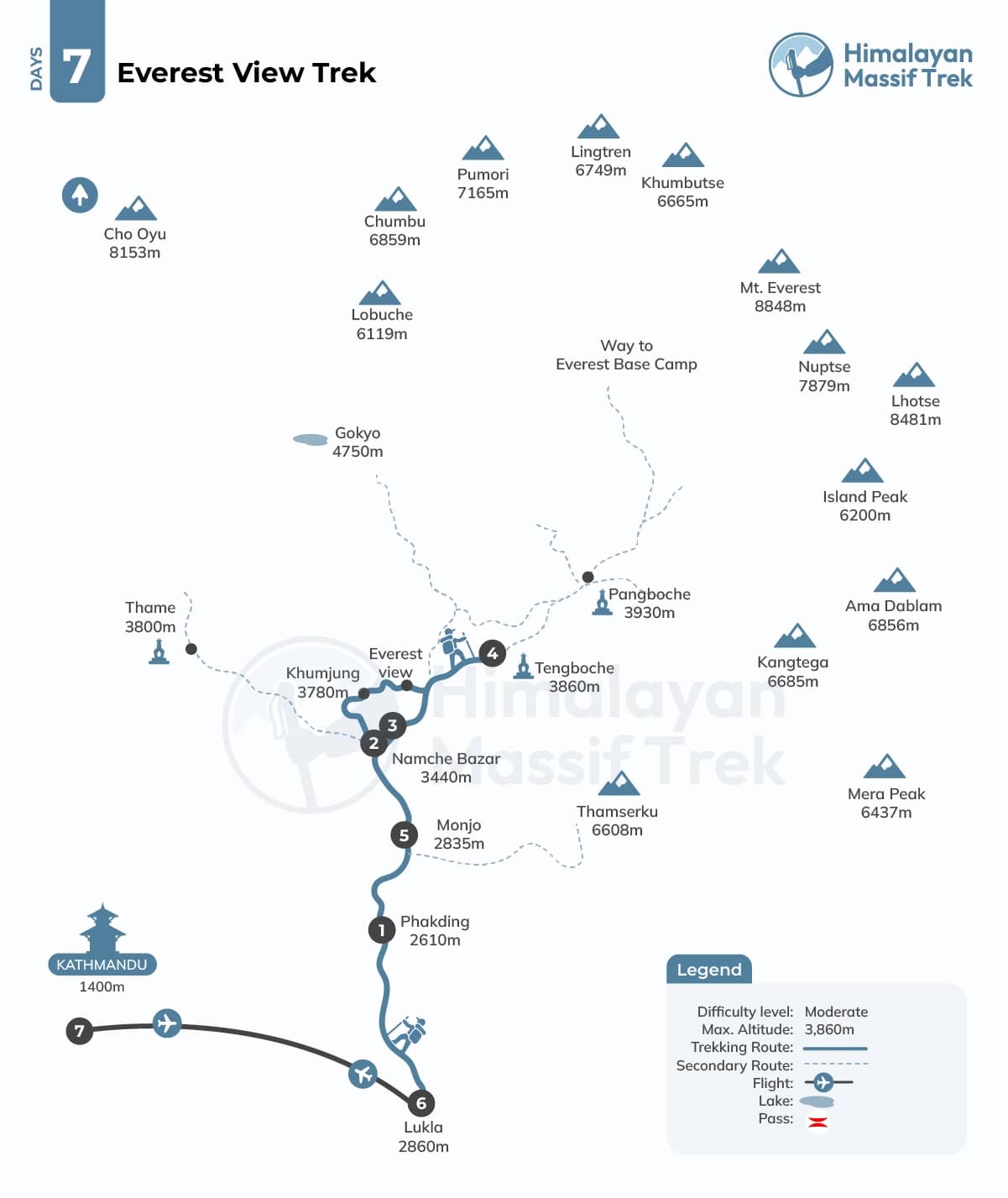

Cost Details
Accommodation:
- 6 nights comfortable lodge during the trek
Meals:
- 3 Standard meals a day ( Set of breakfast, Lunch and dinner)
- Farewell dinner in Kathmandu on the last night
Transportation and flights:
- Domestic airport pick up and drop
- Flight to Lukla from Kathmandu or Ramechhap and return to Kathmandu
- Drop to Ramechhap (during April, May, October and November)
Guide and porters:
- A highly experienced guide and an assistant guide if the group size is bigger than 6 people.
- A strong porter between two trekkers (he carries up to 20kg of baggage)
Permit and document:
- Local government fees
- National park entry permit
Trekking gears:
- Sleeping bag and down jacket to use for the trek
- HMT T-shirt and duffel bag for free
- First aid kit
Miscellaneous:
- Salary, food and accommodation for guide and porters
- Government taxes and liabilities
- International airfare
- Accommodation in Kathmand
- Travel Insurance and Nepal visa fee
- Lunch and dinner in Kathmandu
- Personal expenses include phone bills, cold and alcoholic drinks, laundry bills.
- Personnel trekking gear
- Tipping for trekking guide and porters
To confirm your payment, a deposit payment is required, which is 30% of the total booking price. This deposit helps us secure permits, logistics, and other necessary arrangements for your trek.
We understand that plans can change, and we strive to be as flexible as possible. However, to cover operational costs, a cancellation fee applies. This is a percentage of your total booking price and is deducted from the deposit payment.
Cancellation Fees
Cancel 30% days before departure: 5% of the trip cost
Cancel between 10 to 30 days before departure: 10% of the trip cost
Cancel within 10 days of departure: 20% of the trip cost
If you need to cancel, please notify us as early as possible to reduce charges.
Rescheduling
Unexpected circumstances can disrupt travel plans, even if you still want to do the trip. To support our clients, we have generously waived all rescheduling fees. You can postpone and reschedule your trip at no additional cost, as long as the new departure date falls within one year of your original booking.
Upgrades
If you wish to upgrade your accommodation, transportation, or any other services not mentioned in the Trip Includes section, please be aware that these upgrades will incur additional costs. We can assist in arranging these options for you based on your preferences and availability.
Lukla Flights
Non-Refundable Flight Ticket: If you need helicopter evacuation or other means of transport due to altitude sickness or any other condition, your return flight ticket fare is non-refundable.
Refundable Flight Ticket: If the flight operator cancels your flight due to bad weather in Lukla, Kathmandu, or any other reason, your flight ticket fare is 100% refundable.
Dates & Availability
Private TripIf you don't find an appropriate date, you can propose a Preferred Departure Date, and we’ll ensure the trip runs as scheduled just for you.
Trip Gallery
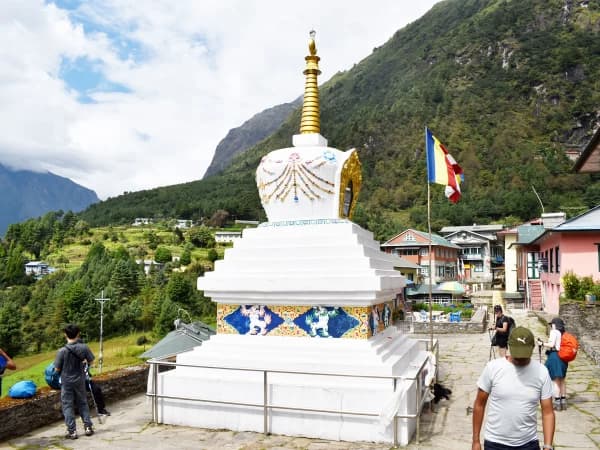

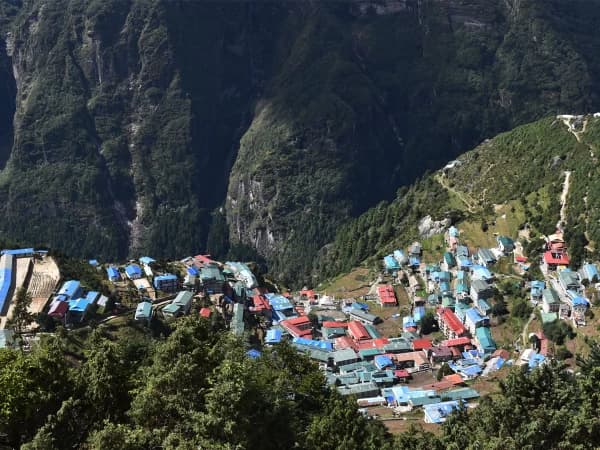
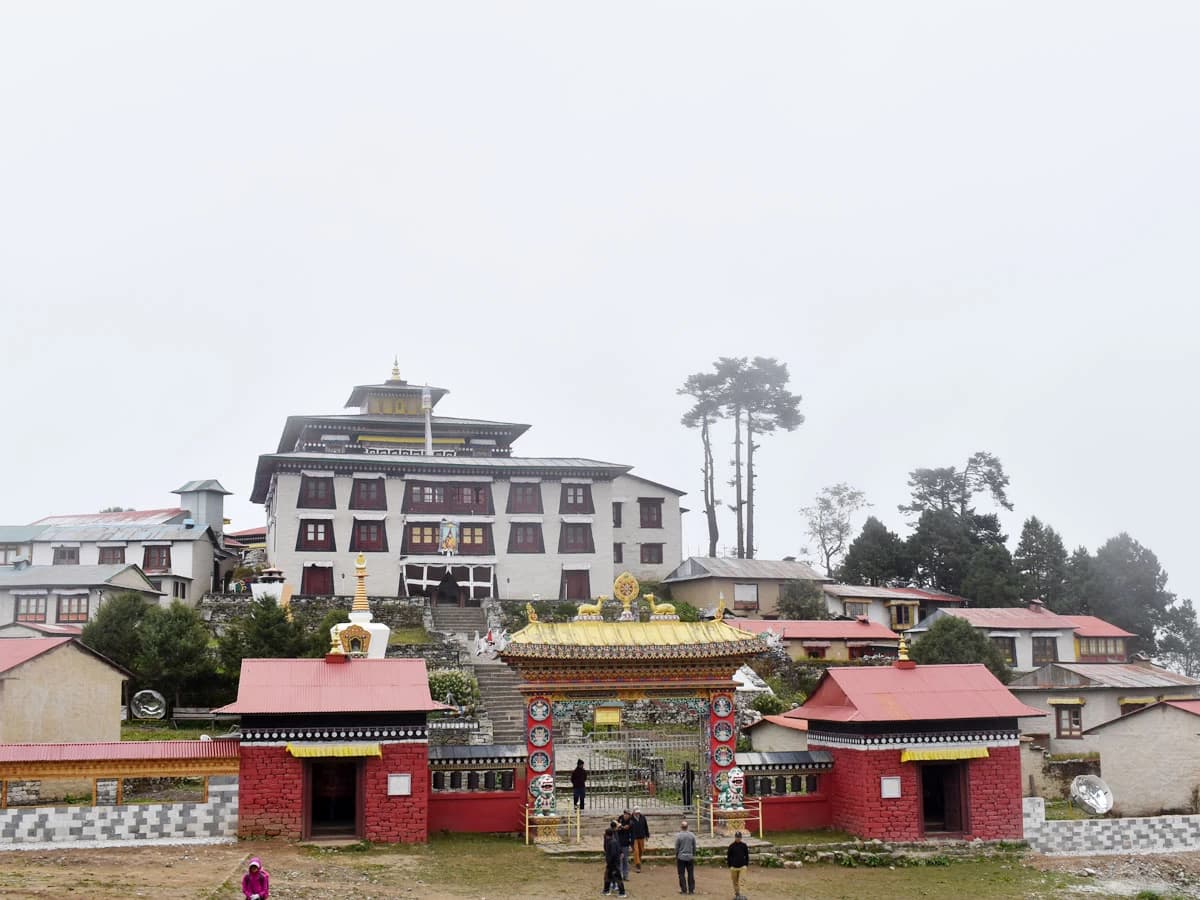
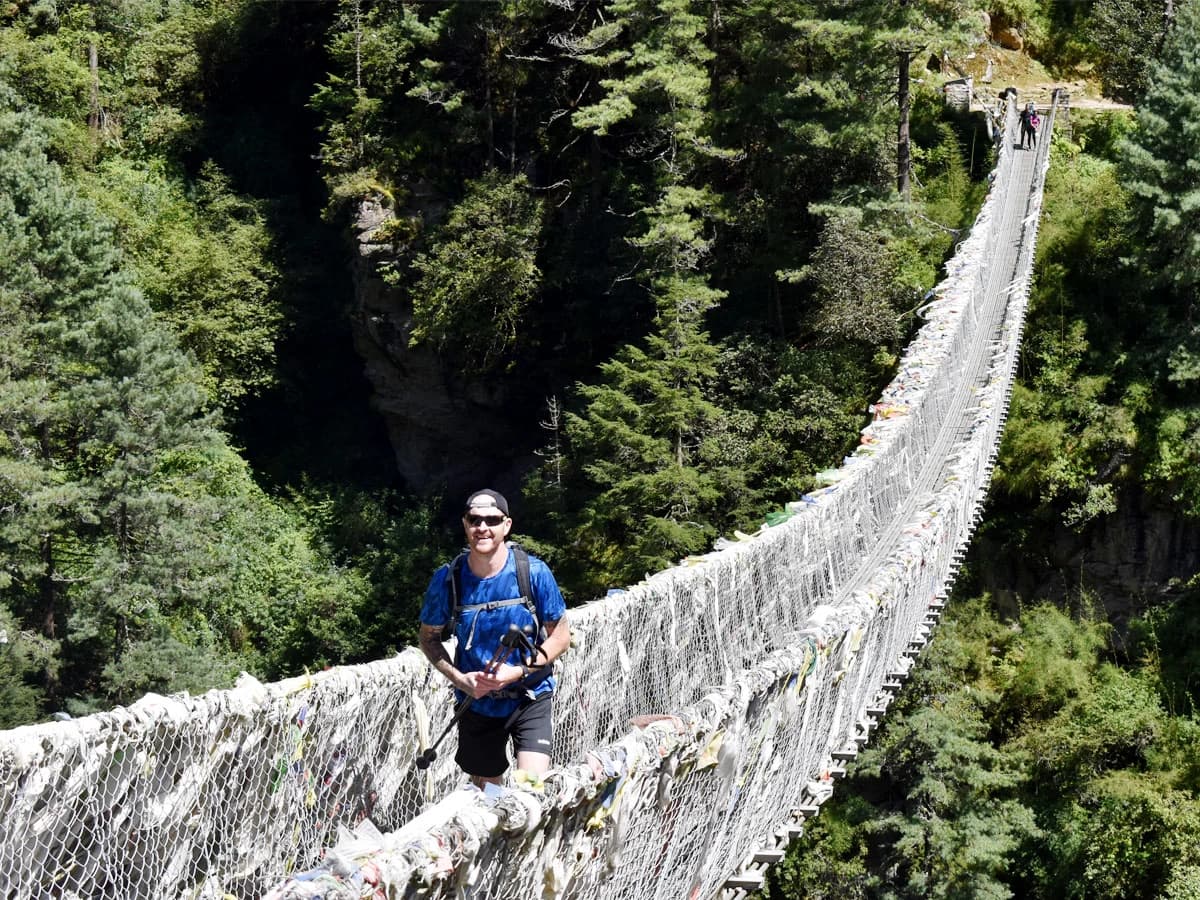
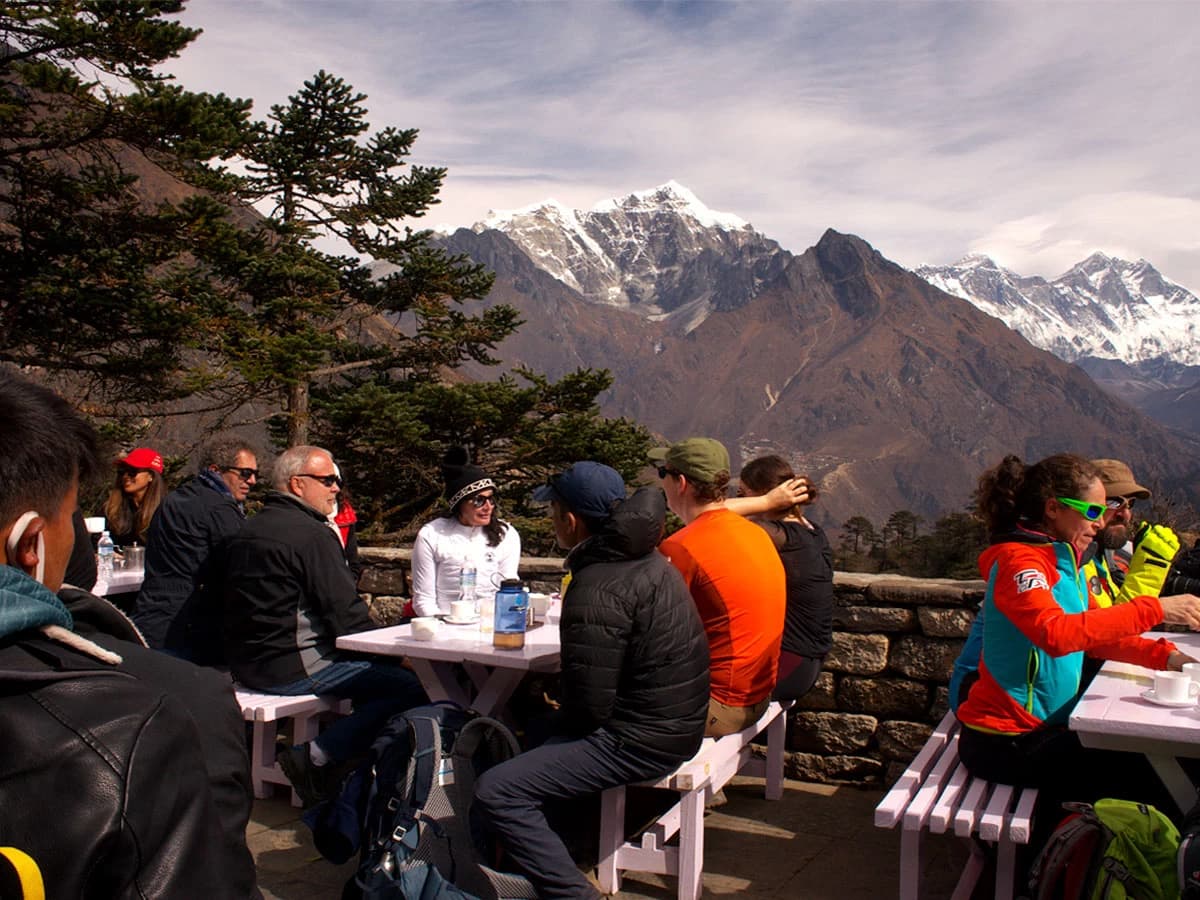
Essential Information
Emergency and Rescue Services
The Everest View Trek traverses through remote Himalayan terrain, where safety and preparedness are essential. While the trek is considered moderate in difficulty, emergencies can still arise due to altitude sickness, injuries, or other unforeseen circumstances.
Here’s what you need to know about emergency and rescue services:
Available Rescue Services
In case of a medical emergency or severe altitude sickness, helicopter evacuation is the most reliable and rapid rescue option. The service is available from key locations like Namche Bazaar and Tengboche, ensuring swift transport to advanced medical facilities in Kathmandu.
Experienced guides and staff from Himalayan Massif Trek are trained to handle emergencies, including administering first aid and assisting in arranging evacuations.
Medical Facilities
The Khunde Hospital near Namche Bazaar and health posts in the region provide basic medical care for trekkers. In critical cases, immediate evacuation to Kathmandu may be necessary for comprehensive treatment.
Insurance Requirement
It is mandatory to have comprehensive travel insurance that covers high-altitude trekking, emergency helicopter rescues, and medical expenses. Ensure your policy includes coverage up to 4,000 meters, which is the maximum elevation of the Everest View Trek.
Himalayan Massif Trek assists in coordinating rescue operations but requires trekkers to provide insurance details beforehand for efficient processing.
Weather Conditions and What to Expect
The weather on the Everest View Trek can vary significantly depending on the season and altitude. While the trek is at a moderate elevation compared to higher-altitude treks, temperatures can still drop sharply, especially during mornings and evenings. The weather in the Everest region is highly unpredictable—one moment, the sun might shine brightly, offering stunning mountain views, and the next, fog or clouds can obscure visibility and bring a noticeable chill.
Seasonal Weather Overview
Here’s a detailed breakdown of temperatures and weather conditions trekkers can expect:
|
Season
|
Daytime Temperature
|
Nighttime Temperature
|
Weather Conditions
|
What to Expect
|
|
Spring (March-May)
|
10°C to 15°C
|
-5°C to 0°C
|
Clear skies, mild temperatures, blooming rhododendrons
|
Pleasant trekking conditions; mornings and nights are cold, but days are comfortable with stunning views.
|
|
Summer (June-August)
|
15°C to 20°C
|
5°C to 10°C
|
Warm, but with heavy monsoon rains and occasional fog
|
Frequent rain and cloudy skies; trails can be slippery. Limited visibility but lush greenery.
|
|
Autumn (Sept-Nov)
|
10°C to 15°C
|
-5°C to 0°C
|
Stable weather, clear skies, and dry conditions
|
Frequent rain and cloudy skies; trails can be slippery. Limited visibility but lush greenery.
|
|
Winter (Dec-Feb)
|
0°C to 5°C
|
-10°C to -5°C
|
Stable weather, clear skies, and dry conditions
|
Ideal trekking season with crisp air and panoramic mountain views. Nights are colder at higher elevations.
|
Key Things Trekkers Should Know
Layering is Essential: Mornings and evenings are significantly colder than middays. Dressing in layers helps you adjust to changing temperatures.
Unpredictable Weather: Even in the best seasons, conditions can change rapidly. Carrying weatherproof gear like rain jackets and windbreakers is recommended.
Sunny Yet Cold: Direct sunlight can feel warm, but shaded or windy areas remain cold. UV protection is important.
Temperature Variations by Altitude: Higher locations like Tengboche are colder than Namche Bazaar. Even short gains in altitude can result in lower temperatures.
Sun Protection: Even on cold days, UV radiation can be strong at higher altitudes. Use sunscreen and wear appropriate clothing.
By understanding the seasonal weather patterns and preparing accordingly, you can ensure a safer and more enjoyable trekking experience in the Everest region.
Difficulty Level
The Everest View Trek is notably easier than longer and more strenuous routes in the Everest region, such as the Everest Base Camp (EBC) Trek or the Gokyo Lakes Trek.
However, while it requires less time and effort, it still presents certain challenges that trekkers should be prepared for, including changes in altitude, trail conditions, and varying weather.
One of the key factors affecting the trek’s difficulty is altitude. Although the highest point on the Everest View Trek is approximately 3,867 meters (12,687 feet) at Tengboche, the effects of high altitude can still be felt, especially for beginners. Symptoms of mild altitude sickness, like headaches and shortness of breath, are possible, making acclimatization important.
An acclimatization day in Namche Bazaar, built into our itinerary, helps trekkers adjust gradually. Compared to the Everest Base Camp Trek, which ascends to 5,364 meters (17,598 feet), this trek poses a much lower risk of severe altitude issues.
Trekkers will face steep ascents and descents, particularly when climbing to Namche Bazaar and Tengboche. Technical climbing skills are not necessary, making the trek accessible to most. The trek is beginner-friendly and suitable for families or older adventurers with basic fitness levels.
Permits and Documentation
For the Everest View Trek, obtaining the correct permits is essential to ensure a smooth and legal trekking experience. The following permits are required, and our team at Himalayan Massif Trek will arrange all necessary documentation on your behalf:
Sagarmatha National Park Entry Permit
All trekkers entering Sagarmatha National Park must obtain this permit to access the protected area. This permit contributes to conserving the park’s unique biodiversity and landscapes.
Cost:
- International tourists: NPR 3,000 (approx. USD 23)
- SAARC nationals: NPR 1,500 (approx. USD 12)
- National tourists: NPR 100
Khumbu Pasang Lhamu Rural Municipality Permit
This permit is mandatory for trekking in the Khumbu region, replacing the TIMS card previously used. It supports local infrastructure and tourism management.
Cost:
- All trekkers (both SAARC and international): NPR 2,000 (approx. USD 15)
TIMS (Trekkers’ Information Management System) Card
Cost:
- Approx. USD 10.
Requirement: A TIMS card is required for all trekkers in Nepal to track trekkers’ movements and ensure safety. The card is available at the Nepal Tourism Board and through trekking agencies.
These permits are essential for the Everest View Trek and must be carried during the journey. Himalayan Massif Trek will arrange all necessary permits for you to ensure a hassle-free experience.
Everest View Trek Equipment List
FAQs
The Everest View Trek is a short, scenic trek in the Everest region, offering stunning views of Mount Everest and surrounding peaks, without the extensive physical demands of a full Everest Base Camp trek.
The trek starts in Lukla after a short flight from Kathmandu or Ramechhap.
The highest point of the trek is Tengboche, at an altitude of about 3,860 meters (12,664 feet).
With Himalayan Massif Trek, you will complete the trek in 7 days. This accounts for the needed acclimatization days and the right pace.
In case of sickness or injury, the nearest medical facility is in Namche Bazaar. In severe cases, you will be evacuated by a helicopter.
The Everest View Trek is generally safe, but like any mountain trek, trekkers should follow safety precautions, including hiring experienced guides and staying aware of weather conditions.
Trekkers spend a day or two in Namche Bazaar to acclimatize to the altitude. Popular hikes like a visit to the Everest View Hotel or a short trek to nearby villages help with acclimatization.
While the altitude is lower than at Everest Base Camp, it is still possible to experience mild symptoms of altitude sickness. Proper acclimatization and hydration are essential.
Yes, Namche Bazaar is safe for tourists. It is a well-established stop for trekkers with good infrastructure, healthcare facilities, and a welcoming community. However, trekkers should always follow safety guidelines, especially regarding altitude.
The Everest View Trek is fairly easy, and suitable for trekkers with a reasonable fitness level. It does not involve technical climbing, but some sections are challenging due to altitude.
The Everest View Trek requires a moderate fitness level. It is suitable for those who regularly engage in physical activity like walking or hiking. You don’t need to be an expert trekker, although we recommend preparation hikes and exercise in your home country.
The trek is suitable for people of all age groups as long as they are in good health. Whether traveling solo, in a group, or with a family, we advise you to conduct a health check for all, especially for children and the elderly.
No, prior trekking experience is not necessary, but a good level of fitness is important to handle the altitude and the hike.
You can expect typical Nepali meals like dal bhat (lentils and rice), as well as international options like pasta, noodles, soup, and pancakes.
Most trekkers stay in teahouses or lodges along the route, offering basic but comfortable accommodation.
Essential items include warm clothing, a good pair of trekking boots, a sleeping bag, a water bottle, trekking poles, a headlamp, and sun protection.
The Sherpas celebrate Lhosar (Sherpa New Year, February/March), Mani Rimdu (October/November, celebrating good over evil), Dumje Festival, and Buddha Jayanti (May, honoring the life of Lord Buddha).
Wi-Fi is available at most teahouses for a small fee, though the connection can be slow and unreliable in remote areas.
Expertise and Local Knowledge
At Himalayan Massif Trek, we pride ourselves on our unparalleled expertise and deep connection to the Everest region. Our experienced guides are not only skilled in navigating the rugged trails but also possess an in-depth understanding of the culture, history, and traditions of the Sherpa people.
Our team is composed of local experts who have spent decades exploring the Himalayan belt. Their intimate knowledge of the terrain, weather patterns, and the Everest region’s unique ecosystems ensures a safe, smooth, and enriching trekking experience. Whether you are trekking through the bustling streets of Namche Bazaar or gazing upon the towering peaks, our team’s local insights will make your journey more immersive and memorable.
Authentic Local Experiences
At Himalayan Massif Trek, we believe in offering an authentic, culturally immersive trekking experience. Throughout your Everest view trek, you will have the opportunity to explore Sherpa villages such as Tengboche, Dingboche, and Gorakshep, each with its unique charm and character.
These villages provide a glimpse into the everyday life of the Sherpa people, with opportunities to interact with locals, visit monasteries, and witness traditional customs.
During the trek, you will be served authentic Nepali meals that highlight the flavors of the region, giving you a true taste of the local cuisine. Our guides will share fascinating insights into the Sherpa way of life, from their centuries-old traditions to their warm hospitality, making every step of the journey a rich cultural experience.
By trekking with us, you’ll not only witness the stunning beauty of the Everest region but also gain a deeper understanding of its people and traditions.
Value for Money
At Himalayan Massif Trek, we offer competitive pricing without compromising on quality. Our transparent pricing ensures there are no hidden costs, so you can focus on enjoying your trek without worrying about unexpected expenses.
Our comprehensive packages cover all the essential aspects of your journey, including permits, accommodations, and meals, providing you with a hassle-free experience from start to finish.
We also offer group discounts and special offers for repeat travelers, making it easier and more affordable to explore the Himalayas with us.
Whether you're a first-time trekker or a seasoned adventurer, you will find great value in our well-designed packages that give you everything you need for a memorable and smooth trekking experience.
Environmental Responsibility
Our company is deeply committed to preserving the natural beauty of the Himalayas and minimizing our environmental impact.
We follow eco-friendly trekking practices to ensure that our activities have minimal effect on the delicate ecosystems of the Everest region. From reducing plastic waste to promoting responsible trekking behavior, we work hard to protect the environment for future generations of trekkers.
We also support the local communities by partnering with local suppliers, ensuring that the economic benefits of tourism stay within the region.
By working with Sherpa-owned businesses and hiring local guides and porters, we help empower communities and contribute to their sustainable growth.
Our commitment to preserving the pristine beauty of the Everest region means that every trek with Himalayan Massif Trek not only provides an unforgettable adventure but also supports the long-term conservation of this majestic landscape.
- Expertise in High-Altitude Trekking Adventures
- Over 18 Years of Experience in The Himalayas
- Authorized and Reliable Trekking Partner
- Trusted by Thousands of Adventurers Worldwide

The Everest View Trek was the perfect introduction to the Himalayas. The trails were manageable, and the views of Everest were stunning. The Himalayan Massif...
This trek was short but packed with incredible scenery. The views of Everest from Tengboche were breathtaking. The guides were friendly and knowledgeable. I highly...
The Everest View Trek was a great way to experience the beauty of the Himalayas without committing to a long trek. The team was professional...
